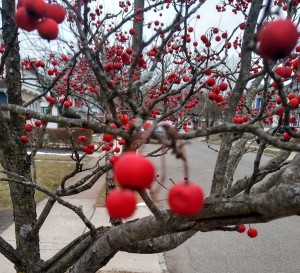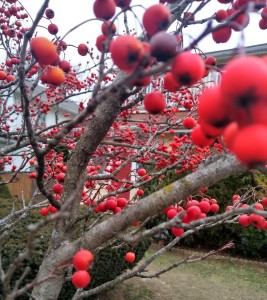 The winter landscape in my neighborhood features a full range of greens—from dead foliage green to glossy dark holly-green. It features an even larger range of grey-browns. In fact, even the omnipresent deer are grey-brown, their coats having morphed from the lovely chocolate shade of summer to something that blends better with the winter landscape.
The winter landscape in my neighborhood features a full range of greens—from dead foliage green to glossy dark holly-green. It features an even larger range of grey-browns. In fact, even the omnipresent deer are grey-brown, their coats having morphed from the lovely chocolate shade of summer to something that blends better with the winter landscape.
This camouflage does not work when a small herd is ambling across a residential street, but it stands the deer in good stead in woodier areas.
With so much dead foliage green and depressing grey-brown upholstering the outdoor world, it is a relief to round a corner and see an ornamental crabapple rife with brilliant red fruit. It is gratifying to think that something so bright and beautiful has survived the early winter storms, not to mention the depredations of hungry birds. Maybe the birds save the best for last, or perhaps the fruits are like rose hips and sweeten as cold weather progresses.
All crabapples are members of the genus Malus, as are common eating apples. Malus is home to many species and a million varieties and hybrids. To cook the topic down to its essence, the main difference between crabapples and standard apples is fruit size. If the fruits are larger than two inches in diameter, they are standard apples. That leaves a range of fruit sizes for crabapples—from tiny, one quarter inch fruits, right up to those that are almost as big as regular apples.
Woody plant guru Michael Dirr wrote this about crabs in the fifth edition of his Manual of Woody Landscape Plants—“I doubt if any treatment of flowering crabapples will ever be complete, for as I write this, someone is ready to introduce a new clone into the trade. The actual number of crabapple types is open to debate but across the country one could probably find 400 to 600,,…”
You have to trust Dr. Dirr on these things, but to my eye at this time of year, the most attractive crabs are the ones that bear an abundance of very small—one quarter to one half inch—fruits. In my neighborhood most of the crabs bear red fruits that hang like jewels on the trees, but I have also seen yellow-fruited specimens, like ‘Autumn Treasure’. Orange-fruited varieties exist as well.
Like other members of the large rose or Rosaceae family, crabs bear five-petaled flowers that are generally pink in bud and may be either shades of pink or white in bloom. The petal count is multiplied in the frilly semi-double or downright opulent double-flowered forms. All bloom in spring and produce fruits in fall.
Crabs are generally either shrubs, like Sargent’s crab or Malus sargentii, or small trees that top out at about 15 feet tall. The small-fruited varieties are sometimes used as street trees because they tend to hold their fruit into the winter months and don’t create the downed-fruit litter characteristic of their larger-fruited relatives. They are equally useful as stand-alone specimens or as anchors in garden beds.
The plethora of crabapple varieties can make choosing hard. If you go to a nursery, inquire which crabs among their stock are most resistant to the various pests and diseases that plague apple family members. Check for mature size and fruit size. If you want to collect the fruits for culinary purposes, like crabapple jelly, buy a large-fruited variety.
There are some small-fruited crabs that are especially lovely, as well as disease resistant, among them Malus hupehensis or tea crabapple. This small tree, which won the Royal Horticultural Society’s prestigious Award of Garden Merit, features fragrant, single white blossoms, and fruits blushed liberally with red. “Adirondack’, with slightly larger—one half inch—fruits, is another resistant variety with pink-tinged white flowers and orange red fruits. ‘Adirondack’ has the advantage of being columnar, making it an easy fit for smaller areas.
If the idea of small, persistent golden fruits is appealing, look for ‘Harvest Gold’ a hybrid crab which produces white flowers from pink buds. The fruits are about three fifths of an inch in diameter and golden yellow. In my experience many people, on sighting a yellow-fruited crab, will ask what it is, making the varieties great conversation pieces as well as excellent ornamental specimens.
Eventually, of course, even crabs with the most persistent fruits will drop those fruits or surrender them to birds. Most likely if you have picked the right variety, fruits will disappear in late winter. By that time you will be only eight to 12 weeks away from spring and the cascade of blooms that crabs produce to celebrate the new season. During that short span of horticultural time you can easily amuse yourself with garden catalogs and inspirational garden literature.
If local garden centers offer a dearth of crabs, find a very good selection at ForestFarm, 14643 Watergap Rd, Williams, OR 97544; (541) 846-7269; www.forestfarm.com. Print catalog available.

